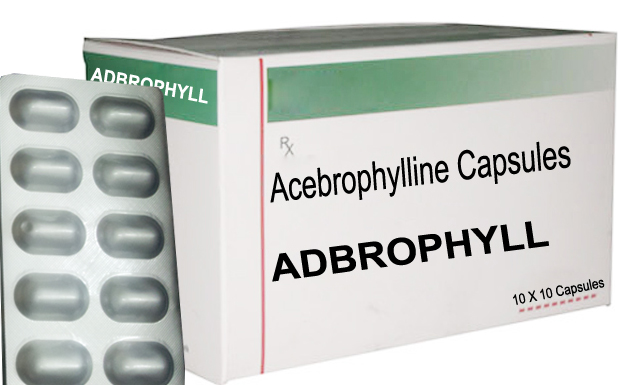Acebrophylline has 3 actions namely bronchodilation, mucoregulation & anti-inflammatory action.
Indications:
Treatment of adult patients with COPD and bronchial asthma.
Usage:
● As it is EDC free, hence safer than conventional Acebrophylline.
● Acebrophylline has both mucous regulating and Bronchodilator effect unlike Theophylline.
● Acebrophylline is more active than Ambroxol alone.
● Acebrophylline has less adverse effect.
Drug Interactions:
The plasma concentration of acebrophylline may be concurrent administration of erythromycin, cephalexin, oxytetracyclline, oligomycin, lincomycin, cimetidine, clindamycin, allopurinol, quinolones, anticoagulants, etc. If concurrent use is essential, the dose of acebrophylline should be reduced. The concomitant use of acebrophylline and frusimide can potentiate dieresis, while concomitant use of acebrophylline with reserpine can cause tachycardia. Acebrophylline plasma concentration may be decreased in patients by co administration with drugs like phenytoin and barbiturates and in patients with smoking habit. Not to use with CNS stimulants.
Mechanism of Action:
Theophylline-7-acetate, as with other xanthinic derivatives, has a bronchodilator effect due to inhibition of the intracellular phosphodiesterases, followed by an increase of adenosine monophosphate cyclic levels, which promote the relaxation of bronchial muscles.
Ambroxol modifies the mucous gel phase of secretions by decreasing the viscosity and increasing the serous gel phase. It increases the mucociliary clearance by stimulating cilia motility.
Acebrophylline inhibits phospholipase A, and phosphatidylcholine leading to lesser production of the powerful pro-inflammatory substances like leukotrienes and tumour necrosis factor. By inhibiting the synthesis and release of these inflammatory mediators, acebrophylline reduces inflammation, a key factor in airway obstruction, specially in chronic forms.
Pharmacology:
Acebrophylline increases the synthesis and release of alveolar surfactant, resulting in triple action: mucoregulation, stimulation of bronchoalveolar clearance, and antiinflammatory-antireactive effect. In patients with chronic obstructive bronchitis, given the drug for 10-20 days, there was a good reduction in expectorate Viscosity.
Pharmacokinetics:
200mg oral acebrophylline, the two components of the molecule ambroxol and theophylline-7-acetic acid are released in the stomach and absorbed in the intestine, reaching optimal concentrations of ambroxol within 2hrs and of theophylline-7-acetic acid after 1 hr. The plasma half life varies from 4 to 9 hrs after oral administration. The drug is metabolized in the liver and eliminated renally.
Side Effects:
Epigastric pain, Nausea, Vomiting, Diarrhoea.
Contraindications:
Hypersensitivity to ambroxol, aacebrophylline, theophylline or any other xanthine derivative,Patient suffering from acute myocardial infarction, hypotension, hemodynamic instability and arrhythmias, renal disease or liver disorder.
Adverse Effects:
Abdominal, discomfort, stomach/ abdominal distenson, vomiting, diarrhea, constipation, heart burn, loss of appetite, esophageal bleeding, rashes, urticaria, itching, drowsiness, difficulty in breathing, leukocytosis and nasal inflammation. If chills and fever occur, the drug should be immediately discontinued. Tachycardia, fatigue, hypertension, albuminuria, glycosuria, hypotenstion, occastonally hyperglycemia.
Storage:
Store at room temperature, 15-30° C (59-86°F). Keep away from moisture.
